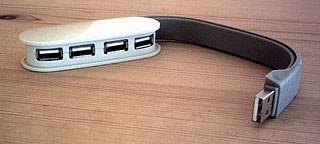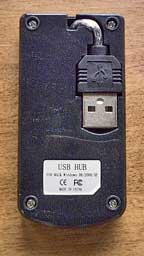With the proliferation of USB devices - and especially now with an
apparent phase-out of FireWire support underway in Apple products - the
once prosaic and humble USB hub has taken on a greater importance in
the Mac computing world.
I/O Challenged 'Books
Indeed, Apple has evidently embraces philosophy of I/O minimalism
reaching back to the
original clamshell iBook with its one lonely USB port nearly ten
years ago, and in a broader context even back to the port-challenged
PowerBook 150 in the mid-90s (one
serial port, no ADB port).
The poor little MacBook
Air also ships was just one USB port, despite the fact that it
relies on USB for all of the growing list of usual things plus its
optional external optical drive, and a complete absence of built-in
ethernet and FireWire ports (ethernet is available though an optional -
you guessed it - USB adapter). You can't connect a wired mouse and
keyboard simultaneously unless the latter has a USB repeater port,
something more and more rarely included on today's crop of compact,
thin keyboards, and some wireless input devices require a USB dongle
receiver.
Then there are USB mics for those of us who use dictation software
or Internet telephony. My Revolabs USB microphone has a USB-connected
receiver. Hooking up printers or scanners will have to be via USB
unless you have wireless units, as will downloading photos from a
digital camera.
Of course, the counter-argument is that the MacBook Air is designed
and intended for predominantly wireless connectivity, but in the real
world that is still often more an ideal than a practical reality.
Less FireWire
The new Unibody
MacBook and 15" Unibody MacBook
Pro still have a measly two USB ports, having lost their erstwhile
FireWire 400 ports with nothing to compensate (the Pro model still has
a FireWire 800 port that can support FireWire 400 devices via an
optional adapter), while even lowly PC netbooks selling for $300 manage
to include three USB ports. The only Mac notebook as well equipped
being the 17"
MacBook Pro, and it just lost its FireWire 400 port as well.
Less USB Power
Then there' the revelation that the MacBook and MacBook Pro's two
USB ports are not created equal, with only one of them supporting a
full powered USB device. Nor is it just MacBooks - I've found that the
right USB port on my 1.33 GHz G4 PowerBook, a
model that debuted in September 2003, doesn't supply enough juice to
spin up one of my external USB 2.0 hard drives (which has a relatively
low power demand 4200 RPM 2.5" notebook drive in situ), although my
G3 iBook and
Pismo PowerBooks seem
to have no trouble bus-powering that drive. However, with the PowerBook
I'm obliged to hook it up to an external power brick.
Back in August 2007, ZDNet's David Berlind posted a technical article on this
topic that's worth checking out if you're interested in the topic.
Berlind notes that while all USB ports offer 5
volts, amperage (i.e.: the volume of power available) can vary
substantially, which is an important factor when it comes to
bus-powering devices like external hard drives. The standard amperage
required by powered devices is 500 milliamps (mA) while unpowered
devices require only 100 mA, Some computers - or even different ports
in the same computer - sometimes offer more, which means that if your
external hard drive won't power up from one USB port on your 'Book,
it's worth a shot at least trying it in another before rummaging around
for a power brick.
Anyway, the long and short of it is that the most MacBook users are
going to need a USB hub, and perhaps more than one. I've been getting
along very nicely with an old Keyspan
4-port powered hub in translucent strawberry plastic since the days
when that livery contemporaneously harmonized with the fruit-color iMacs of the
day, but there have been some innovations in USB hub design and
technology over the past decade.
Targus for Mac USB Hub
One
of the very newest-design hubs on the market is the Targus for
Mac USB Hub, designed especially for Mac users as part of Targus's
new "for Mac" family of computer peripherals and accessories.
 This
hub's main claim to a distinction its its avant garde styling, themed
to match the soft-cornered, ovoid form factors of the Targus for Mac
mice and Bluetooth Presenter products, as well as its wraparound cable
made of a soft material that stores fitted snugly and neatly around the
hub body to protect the USB ports when not in use and when the unit is
carried in a pocket or laptop case, protecting them for damage and
ingress of tiny debris.
This
hub's main claim to a distinction its its avant garde styling, themed
to match the soft-cornered, ovoid form factors of the Targus for Mac
mice and Bluetooth Presenter products, as well as its wraparound cable
made of a soft material that stores fitted snugly and neatly around the
hub body to protect the USB ports when not in use and when the unit is
carried in a pocket or laptop case, protecting them for damage and
ingress of tiny debris.
MInimalist in form and simplicity of engineering, the Targus
for Mac USB Hub simply extends a single USB 2.0 port's connectivity
from one device to four, with a maximum throughput of 480 Mbps.
The Targus for Mac USB Hub measures 3.5" x 1.75" x 0.75" and weighs
a feather-light 1.8 ounces. The wraparound cable unfolds to a maximum
of 9", and system requirements specify Mac OS X 10.2 or later,
although I don't see why it wouldn't work with any version of the Mac
OS that supports USB.
The hub is very sleek-looking and attractive in the Targus for Mac
family's signature "Lunar Grey", and the wraparound cable feature is
interesting and eliminates tangly cable clutter. The only shortcoming -
and it could be significant - is that there is no provision for
self-powering, even as an option, so it can only support connection of
multiple low current demand peripherals.
However, if self-powering does not factor greatly into your needs
and requirements, and especially if you need a nice-looking and
convenient USB hub to take with you on the road, this one merits
consideration. The finish, and quality of materials and workmanship are
first-rate, and the price is competitive at $29.99. It's covered by a
one-year limited warranty.
Proporta 4 Port USB Compact Hub
 Another 4-port USB that especially very nicely complements the
MacBook Air's compactness and portability is Proporta's
4 Port USB Compact Hub, whose trim dimensions and feather-light
weight let it fit comfortably in a shirt pocket or purse. It also has a
USB male connector small enough to fit comfortably in the MacBook Air's
recessed USB port.
Another 4-port USB that especially very nicely complements the
MacBook Air's compactness and portability is Proporta's
4 Port USB Compact Hub, whose trim dimensions and feather-light
weight let it fit comfortably in a shirt pocket or purse. It also has a
USB male connector small enough to fit comfortably in the MacBook Air's
recessed USB port.
The Proporta hub quite sharp-looking too, with a metallic charcoal
finish and a blue indicator LED that glows when the unit is powered up
either via bus power or a supported 5V power supply (which must be
purchased from a third party).
The Proporta 4 Port USB Compact Hub is about the size and shape of a
jumbo pack of chewing gum and has a smaller footprint than a PC Card,
although it's thicker. The USB plug, which lives at the end of a very
short cable, conveniently and neatly tucks into a dedicated recess in
the bottom of the hub housing for storage and transport.
Three of the Proporta hub's four USB ports are arrayed along
the right-hand side of the unit, while the fourth lives at the bottom.
There is also a socket for a standard 1/8" power supply connector jack
at the top (USB plug) end of the housing, although such a power supply
is not available from Proporta.
Construction and materials quality appear to be very satisfactory,
and no drivers or software installation are needed with a Mac; it's
pure plug-and-play.
The Proporta 4-Port USB compact Hub sells for $25.95.

 This
hub's main claim to a distinction its its avant garde styling, themed
to match the soft-cornered, ovoid form factors of the Targus for Mac
mice and Bluetooth Presenter products, as well as its wraparound cable
made of a soft material that stores fitted snugly and neatly around the
hub body to protect the USB ports when not in use and when the unit is
carried in a pocket or laptop case, protecting them for damage and
ingress of tiny debris.
This
hub's main claim to a distinction its its avant garde styling, themed
to match the soft-cornered, ovoid form factors of the Targus for Mac
mice and Bluetooth Presenter products, as well as its wraparound cable
made of a soft material that stores fitted snugly and neatly around the
hub body to protect the USB ports when not in use and when the unit is
carried in a pocket or laptop case, protecting them for damage and
ingress of tiny debris. Another 4-port USB that especially very nicely complements the
MacBook Air's compactness and portability is
Another 4-port USB that especially very nicely complements the
MacBook Air's compactness and portability is 
